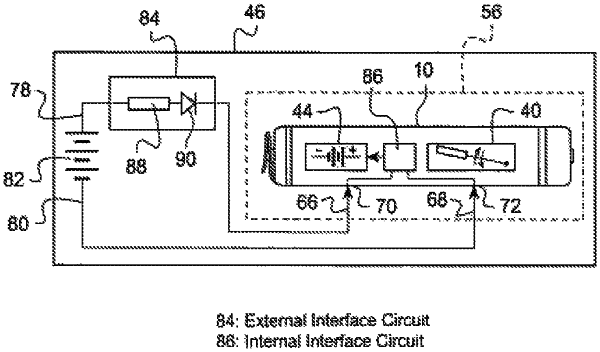| CPC A61N 1/3785 (2013.01) [A61N 1/0565 (2013.01); A61N 1/3756 (2013.01); A61N 1/3787 (2013.01); A61N 1/37205 (2013.01); A61N 1/37223 (2013.01); A61N 1/37512 (2017.08); H02J 7/32 (2013.01); A61N 1/36139 (2013.01); A61N 1/3727 (2013.01); A61N 1/37229 (2013.01)] | 11 Claims |

|
1. An autonomous cardiac implant of the leadless capsule type, comprising:
a tubular body;
surface electrodes carried by the tubular body, including a surface detection/pacing electrode for detecting/pacing cardiac potentials;
a detection/pacing circuit coupled to the surface detection/pacing electrode;
an energy harvesting module adapted to convert external stresses applied to the implant into electrical energy, comprising an inertial pendular unit including an elastically deformable element coupled to an inertial mass;
a rechargeable battery adapted to be charged by the energy harvesting module, the battery being previously charged to an initial charge level; and
an interface circuit adapted to selectively couple the surface electrodes to the rechargeable battery, comprising a switching circuit adapted to operate a switching between (i) a transport and storage configuration before implantation of the implant and (ii) a functional configuration after the implant has been implanted,
wherein:
in the transport and storage configuration the surface electrodes are connected to a link coupling to an external source forming an electrical energy reserve, the external source being physically separated from the implant, wherein the interface circuit is adapted, to receive a power supply from the external source and to release this power supply to the rechargeable battery, and
in the functional configuration the surface electrodes are decoupled from the external source,
wherein at least one of the implant surface electrodes is an auxiliary surface electrode distinct and different from said cardiac potential detection/pacing surface electrode,
wherein the interface circuit is further adapted to selectively couple the detection/pacing circuit to (i) the surface detection/pacing electrode and (ii) the auxiliary surface electrode, and wherein:
in the transport and storage configuration, the interface circuit (i) couples the auxiliary surface electrode to the implant rechargeable battery, and (ii) couples the detection/pacing surface electrode to the implant rechargeable battery and decouples the detection/pacing surface electrode from a detection/pacing circuit of the implant, and
in the functional configuration, the interface circuit (i) decouples the auxiliary surface electrode from the implant rechargeable battery, (ii) puts the auxiliary surface electrode to a floating potential, and (iii) couples the detection/pacing surface electrode to the implant detection/pacing circuit and decouples the detection/pacing surface electrode from the implant rechargeable battery.
|